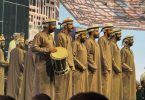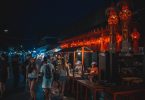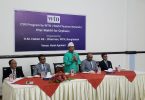BEIJING – The magnificent and massive reconstruction of Donglin Temple – including a man-made hill and grotto — is one of Jinshan District’s prime attractions for the World Expo.
The aim is to attract both tourists and pilgrims from around the world to the 20-hectare site in Zhujing Town in Shanghai’s southwest.
It is one of the five important Buddhist sites in Jinshan District and tours cover all the monuments.
Donglin Temple, first built in 1308 as a temple to worship Guanyin (the bodhisattva associated with compassion), was totally rebuilt and redesigned, beginning in 2004. It was finally completed in 2007.
Only a small part of the original structure remained and it is now a protected relic that survived wars, fire, neglect and various repairs.
“We reconstructed Donglin Temple to a high standard and it now has a brand-new style,” says Wang Keqi, vice director of the Jinshan Tourism Bureau. “We hope people from all over the world can appreciate Donglin Temple during the Expo.”
The site is dominated by new overpowering structures: one hall of white stone is topped by gilded domes and the adjacent Guanyin Pavilion is built into an enormous red artificial hill. A Buddha head stands on the top.
Visitors appear to enter a cave through enormous copper doors, 20 meters high and more than 10 meters wide. They are carved with 999 images of Buddha.
The 1,200-square-meter Guanyin Pavilion is said to be the biggest in Asia. It measures 35 meters in height, 31 meters in width and it is 42 meters deep. Total volume is a staggering 3.5 million cubic meters.
Within stands the glorious, golden, Thousand-hand Guanyin herself. She is 27 meters high with a 2-meter-high lotus base, and arms reaching 5 meters almost to the ceiling. It is said to be the world’s biggest indoor Guanyin statue.
In a temple courtyard stands a 5.4-meter-high Zenzai good luck boy made of brilliant cloisonne enamel. It rotates 360 degrees in seven and a half minutes. Around the boy are eight copper fish, each voicing a different blessing when visitors toss a coin into the statues’ mouths.
Every August pilgrims arrive for a month of prayer. Incense fills the air.
“To maintain ancient treasures and promote Chinese culture, the Jinshan government supports reconstruction to create a spacious environment for believers from all over the world,” says Wang.
There’s a legend about Guanyin, told in the “Miao Ying Bao Juan” about the story of the goddess.
Once upon a time a man had three daughters and after the first and second wed, the youngest refused to marry and decided to become a nun.
The enraged man told his disobedient daughter to commit suicide.
She tried but was not able to take her own life with a sword because it broke before killing the sainted girl. So her father killed her with his own hands.
However, the gods saved her, placing her inside a lotus near Mt Putuo where she helped people who were ill.
When her wicked father was dying, she sacrificed her life in his place and was transformed into the Avalokitesvara.
The Jinshan Tourism Bureau cooperates with a tourist agency to create a Buddhist travel route covering five sites — Donglin Temple, Peasant Picassos, Fengjing Ancient Town, City Beach and farm fun. Donglin Temple is only an hour’s drive from downtown Shanghai.
“We believe the Donglin Temple will be a fascinating place for religious people, and we hope more people can appreciate Buddhism during the Expo,” says tourism bureau vice director Wang.






















